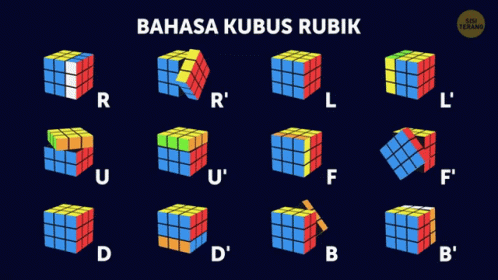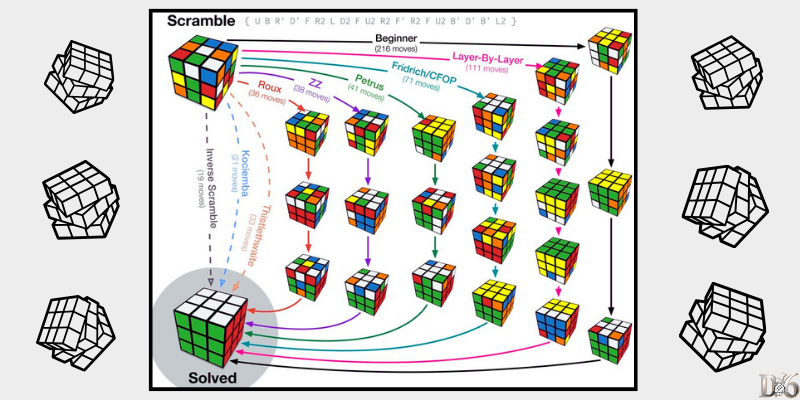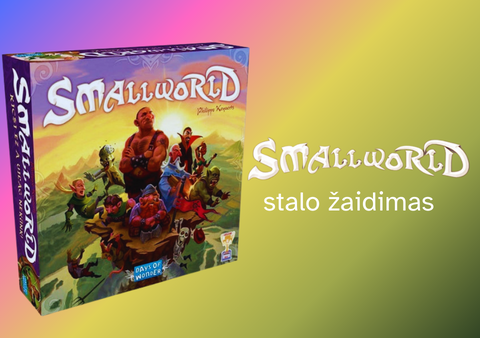The classic Rubik's Cube (also known as the 3x3x3 cube) is one of the world's most popular logic puzzles.
It was created by Ernő Rubik in Hungary in 1974 and has since become a worldwide favourite. The game has remained very popular until today.
In this article, we will discuss in more detail the rules, formulas, pros and cons of this logic game.
Key facts
| Created by | 1974 m. |
| Type | logical |
| Number of players | 1 |
| Complexity | Sophisticated |
| Age of players | from 3 years |
Briefly about the game
Goal
Collect all six colours (red, green, blue, orange, yellow and white) on a given side of the cube and try to do it as quickly as possible.
Complexity
The complexity varies depending on the size of the cubes, the number of colours and the mixing methods. The larger the cube and the more colours, the more difficult it is to put together.
In the case of a classic 3x3x3 cube, the average player needs between 50 and 100 turns to solve the problem, using the right methodology.
However, for more complex cubes, such as a 7x7x7 cube, the probability of completing it may be much lower and the game may take much longer. This depends on the player's skill and experience.
Rubik's cube axes
The classic Rubik's Cube is arranged in a 3x3x3 matrix, which means that it has three axes around which it can rotate. These axes are:
- Horizontal (x) axis: A Rubik's Cube can rotate around a horizontal axis, that is, it can be rotated so that the top and bottom parts of the cube change places.
- Vertical (y) axis: The cube can rotate around the vertical axes, i.e. it can be rotated so that the left and right parts of the cube change places.
- Diagonal (z) axis: The cube can rotate around a diagonal axis, that is, it can be rotated so that the front and back of the cube change places.
These three rotation methods allow you to generate many different positions of the cube.
The pros and cons of the game
✅ Training the mind: Players like that Rubik's Cube requires logical thinking, strategy and a good memory.
✅ Versatility: This a board game people of all ages can play.
✅ Competition: Most Rubik's Cube players compete against each other to get the Rubik's Cube as quickly as possible.
✅ Style and design: Thanks to its colourful design, the Rubik's Cube can not only be a plaything, but also a stylish accessory or a home décor item.

❌ Complexity: The Rubik's Cube is extremely challenging for new players and will take a lot of time and effort to solve.
❌ Frustration: Trying to solve the Rubik's Cube can cause people to lose interest in the game due to constant errors and failures.
How to build a Rubik's Cube?
The classic Rubik's Cube consists of small cubes that can be rotated in different directions to create six cube faces of the same colour.
When rotating a Rubik's cube, all the side colours must be arranged in the same colour as the central colour of that part and each side must be a square of a certain colour.

Description of movements
To understand the assembly of a Rubik's cube, the motions to solve the cube are labelled accordingly and marked with the following symbols:
R - Right colour rotates 90 degrees clockwise.
L - Left colour rotates 90 degrees counterclockwise.
U - The top colour rotates 90 degrees clockwise.
D - The bottom colour rotates 90 degrees anticlockwise.
F - Front colour rotates 90 degrees clockwise.
B - Rear colour rotated 90 degrees anticlockwise.

In addition, there are other markers that indicate that the movement should be made twice (e.g. R2 means that the right colour rotates 180 degrees clockwise).
Key decision methodologies
How do I assemble a Rubik's Cube? There are many methods used to solve the Rubik's Cube, but the main ones are:

Beginner method
First you need to find the white plane and try to collect the white cross and then the whole white plane.
Once the white colour has been collected, the other colours around it must be collected, gradually working towards yellow.
Finally, collect the yellow cross and the adjacent corners of the cube. This should be done until all the pieces of the Rubik's Cube are assembled correctly.
Inverse Scramble solution method
This cube solution is carried out from the shuffled state to the initial state using an algorithm that is more useful for a given moment.
This method is suitable for people who already have a lot of experience with Rubik's Cube. This requires a knowledge of many algorithms and a general understanding of cube solutions.
This method can therefore be quite challenging, but advanced players use it to overcome the monotony that can occur when solving a Rubik's Cube in the traditional way.
Kociemba method
This is one of the most popular ways to build a Rubik's Cube. This method is done by trying to find the shortest way to solve the cube.
The Kociemba method is complex and requires a very good knowledge of algorithms and learning, but it is very efficient because it allows you to reach your goal quickly.
This method requires a lot of effort and long practice, but it is one of the most effective ways to learn how to solve a Rubik's Cube extremely quickly.
Thistlethwaite method
This method is known as the Rubik's Cube Quadrant. This method was developed by James Thistlethwaite in 1981 and is known for its efficiency in reducing the number of steps in the Rubik's Cube assembly.
The Thistlethwaite method consists of four main steps - initially focusing only on the corner elements of the cube and solving the cube using only the edges that are positioned between the corner elements.
In a second step, reducing the number of edge elements. In the third stage, concentrating only on the middle elements, reducing the number of out-of-place cubes, and in the fourth stage solving the remaining elements - the last corners, edges and middle elements.
Roux method
This method was developed by Gilles Roux, a French Rubik's Cube enthusiast. The essence of Roux's method is to divide a Rubik's cube into several parts and perform separate operations on each of them, followed by the assembly of the remaining cubes into their places.
The Roux method is challenging and can take a lot of practice to use effectively. It is therefore worth making use of guides or video tutorials to learn how to use this method properly.
Rubik's Cube ZZ method
The method is named after Lucasz Zalewski (often called Zbiginiew Zalewski).
This method differs from other Rubik's Cube solving methods in that it starts by collecting from the individual faces of the cube, rather than directly collecting the cube as in other methods such as CFOP or Roux.
The ZZ method can be quite complex, especially for beginners, but it has the advantage of being efficient and useful for professional Rubik's Cube solvers.

Petrus method
The Petrus method is based on a number of algorithms and strategies, and its aim is to reduce the arrangement of the cubes to a stage where it can be solved more easily. The method focuses on grouping certain cubes and solving the cube, one block at a time.
This allows you to eliminate many of the moves needed to build a Rubik's Cube, and is very useful for people who already have some experience in Rubik's Cube building.
This method is very efficient and quick to solve, but it can also be challenging for beginners, as it requires the ability to recognise certain blocks and assemble them efficiently.
Rubik's Cube Friedrich (or CFOP) method
This method was developed by Jean-Baptiste Freidrich of the Czech Republic and is one of the fastest ways to solve a Rubik's Cube. CFOP stands for Cross, F2L, OLL, PLL, and in it each of these steps is performed individually in order to complete the whole cube.
When choosing it, the white cross is assembled first, then two layers of colours are dealt with simultaneously.
The basic idea is to pair the cubes from the top layer with the corresponding spots in the bottom layer. In the last step, the yellow cubes are assembled.
Using this method, you can learn to solve a Rubik's Cube much faster than using other methods.
Layer-By-Layer approach
This is one way to assemble a Rubik's Cube, by dividing it into individual pieces and assembling them one by one. This method is a great way to start learning how to solve a Rubik's Cube because it breaks the problem down into manageable parts.
The Layer-By-Layer method is one of the more popular and easier ways to learn Rubik's Cube. The key is to practice and learn the algorithms needed for each step of the method. Finally, a lot of practice and effort will improve your time speed.
A different type of Rubik's Cube
The classic Rubik's Cube is just one of many variations of Rubik's Cube. Other Rubik's cubes may differ in the number of colours, the shapes, or even the way they turn. These variations can make the game even more interesting and challenge the player more.
One of the more interesting variants is the 4x4x4 cube, which has 64 small planes and is twice as complex as the classical cube.
The 5x5x5 cube is even more complex, with 98 small planes. Even more challenging is the 7x7x7 cube, with 294 planes. These larger cubes have more colours and more ways in which they can be assembled.
Records
The official world record for the fastest Rubik's Cube (3x3x3 category) is held by Yusheng Du of China, who solved the Rubik's Cube in 3.47 seconds in 2023.
The world record for the fastest one-handed decision belongs to Max Parker from the UK, who in 2020 solved a Rubik's Cube with one hand in 6.82 seconds
Many advanced players solve a Rubik's Cube in 10 to 20 seconds.
Summary
The Rubik's Cube is a great puzzle that can be a fun challenge and a fun way to pass the time.
It develops the player's thinking and its versatility makes it a favourite among people of all ages. Nevertheless, it can be challenging for new players and can become boring in the long term.
Nevertheless, the Rubik's Cube remains a classic and legendary puzzle with many enthusiasts around the world.
What is the purpose of the game❓
Collect all six colours (red, green, blue, orange, yellow and white) on a given side of the cube.
Is this board game suitable for one player❓
✅ Yes! The game is for one player.
Is the game difficult❓
Yes, the game is complex.
Who created the Rubik's Cube❓
The Rubik's Cube was designed by Ernő Rubik in 1974.
What is the recommended age of players❓
This game is recommended for ages 3 and up.





